Introduction
Research is derived from a French word ‘cerchier’ meaning to seek and ‘re’ stands for again:
- Quantitative Research Topic:
- Self-reported health outcome and sickness benefits among parents of children with a disability (Wendelborg & Tøssebro, 2016).
- Qualitative Research Topic:
- Qualitative analysis of parental observations on quality of life in Australian children with Down syndrome (Murphy et al., 2018).
- Informatics can be incorporated in nursing research.
There are two types of research quantitative and qualitative.
Qualitative research focuses on subjective meaning derived from an individual experience.
Quantitative research is based on the objectivity, study controls, and the ability to specify results.
healthcare informatics entails blending information science, computer application, evidence, and information to support a study. In research scientific methods or systemic analysis is done to answer questions and solve problems.
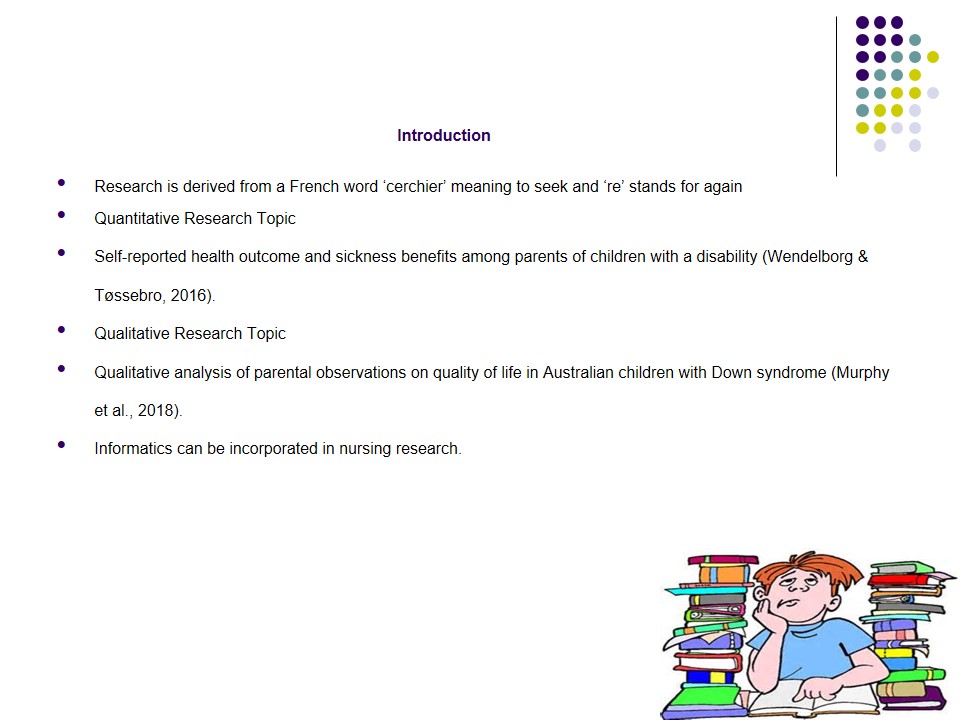
Selected Quantitative Study
- The article examined the health outcome of parents (Wendelborg &Tøssebro, 2016).
- Children with disability negatively impact the health of caregivers.
- Studies based on Norwegian citizens have not been conducted.
- The number of children with disabilities have increased over the past years.
Parents especially mothers are the most common caregivers of children with chronic diseases and disabilities.
The negative health impacts affecting physical, mental, and psychological wellbeing of caregivers have been reported in literature.
This article examines the health outcome and sickness benefits of parents with disabled children.
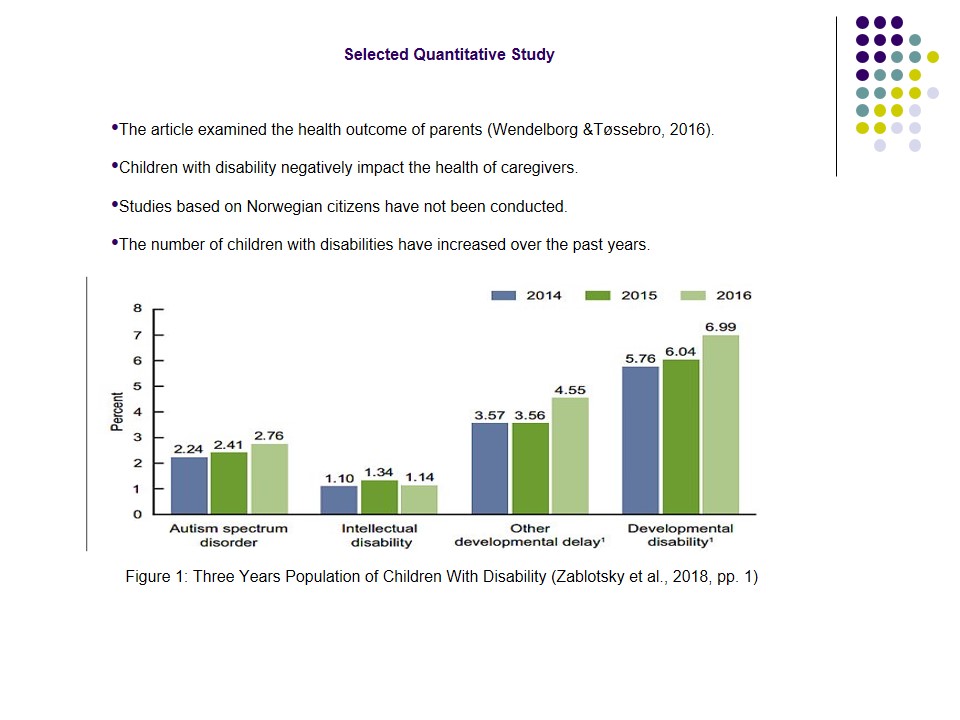
Methods
- The study utilized both objective and subjective measure (Wendelborg &Tøssebro, 2016).
- The researchers identified families with chronic diseases and disabled children.
- The number of parents with disabled children obtaining sickness benefits were matched with that of other parents.
- Income, educational level, and occupation was also compared.
- A survey to gauge quality of life outcome was done through questionnaires.
Objective and subjective measure was used to provide insights of possible health consequences of parenting a kid with disabilities (Wendelborg &Tøssebro, 2016). Population data of families had been registered in FD-Trygd and analyzed the population data obtained.
Mothers participating in the study were asked questions to measure the health indicators, and occupational and educational impacts.
The following questions were asked:
- How is your present state of health?
- Do you suffer from any longstanding illness?
- What kind of work do you currently do?
- What is your highest level of education?’
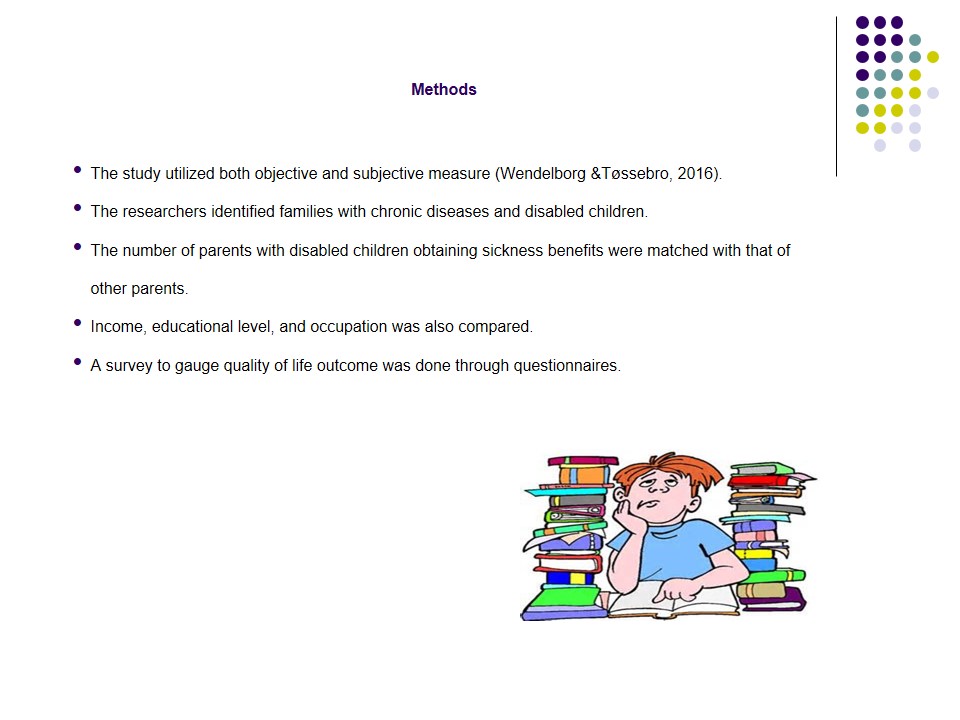
Research Format
- Population data was obtained from a dataset.
- The study was done with objectivity and there was no room for independent variables.
- Design utilized was non experimental design.
- Secondary analysis of data sets obtained from previous study was undertaken.
- A comparative study was incorporated in the research.
Population data was obtained from The Nord-Trøndelag Health Study (HUNT 2) and the historical event database – FD-TrygdI. The differences between two groups was examined based on specific variables.
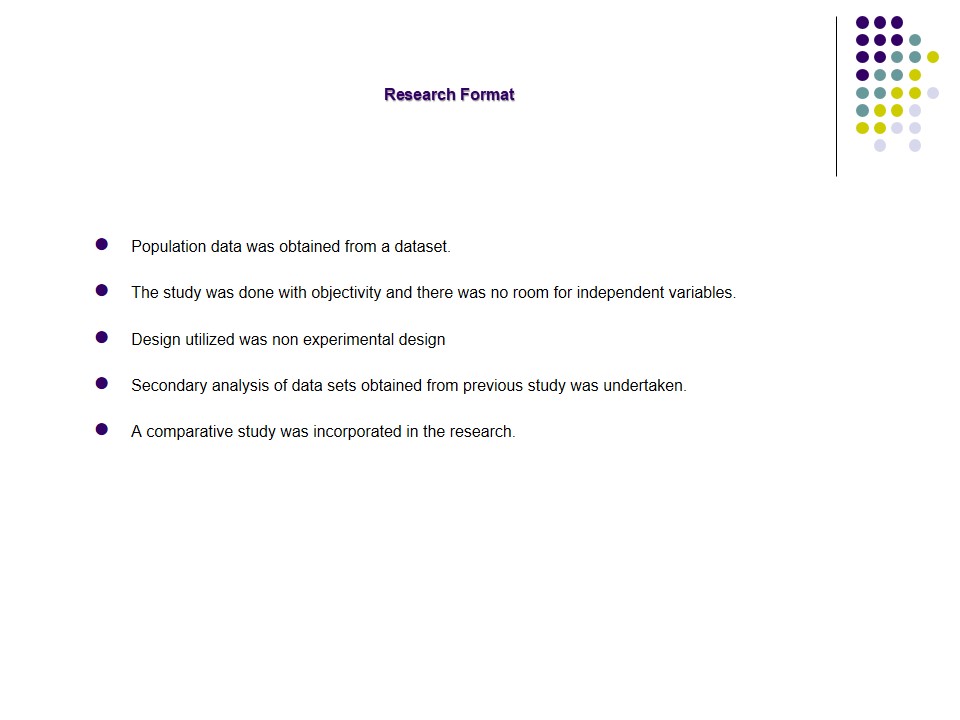
Sample, Findings, and Implications
- The sample size was 1587 parents with disabled children.
- The results, indicated that parenting children with disability has an impact on health outcome of caregivers.
- Parents with disabled children received more sick days off frequently
- Mothers with children with chronic diseases and disabilities are vulnerable groups.
- Lower social economic status and unemployment rate is higher for parents with disabled children.
Lack of employments among parents with disabled children is attributed to their poor health.
Scoring
Four responses ranging from 4-very good to 1 poor rated health status.
Long-standing illness was scored as either yes (1) or no (2).
For the type of work done, ‘Paid work’ and ‘Self-employed’ were recorded as 1, while ‘Full-time housework’, ‘Student, military service’,‘ Unemployed, laid off’ and ‘Retired/on Social Security’. The first two categories were recoded as 0.
Parents with disabled children benefited more from subsidies and aids as compared with parents with normal kids. Most of them were either unemployed or working part time.
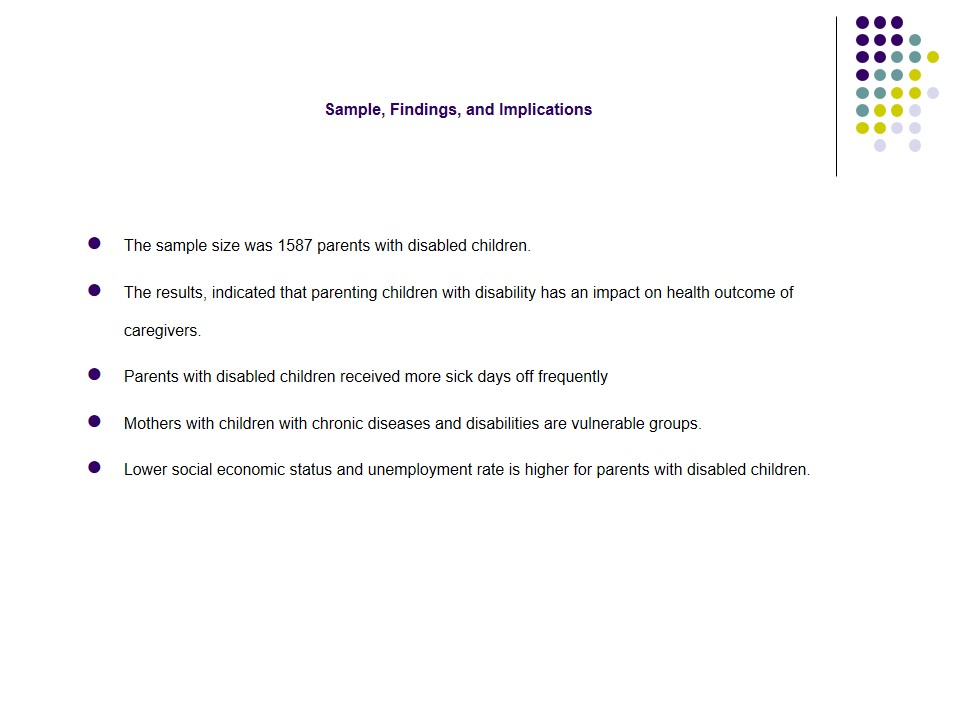
Qualitative Research Methods, Sampling, and Design
- The study aimed at investigating parental comments to ascertain QOL domains in kids with Down syndrome.
- The sample used consisted of 17 families with children living with Down syndrome aged between 6 and 18 years.
- Parents were interviewed to explore the challenging and satisfying factors in the children’s life.
- Qualitative thematic analysis design using grounded theory framework was utilized.
- The study also utilized comparative analysis.
Challenges such as health, participation and functioning for youngsters with Down syndrome had been researched widely. However, information about the quality of life (QOL) information in literature was scarce. The study determined whether the domains affecting children differed between the adolescent and younger children. In addition, It also determined whether the domains affecting children differed between the adolescent and younger children.
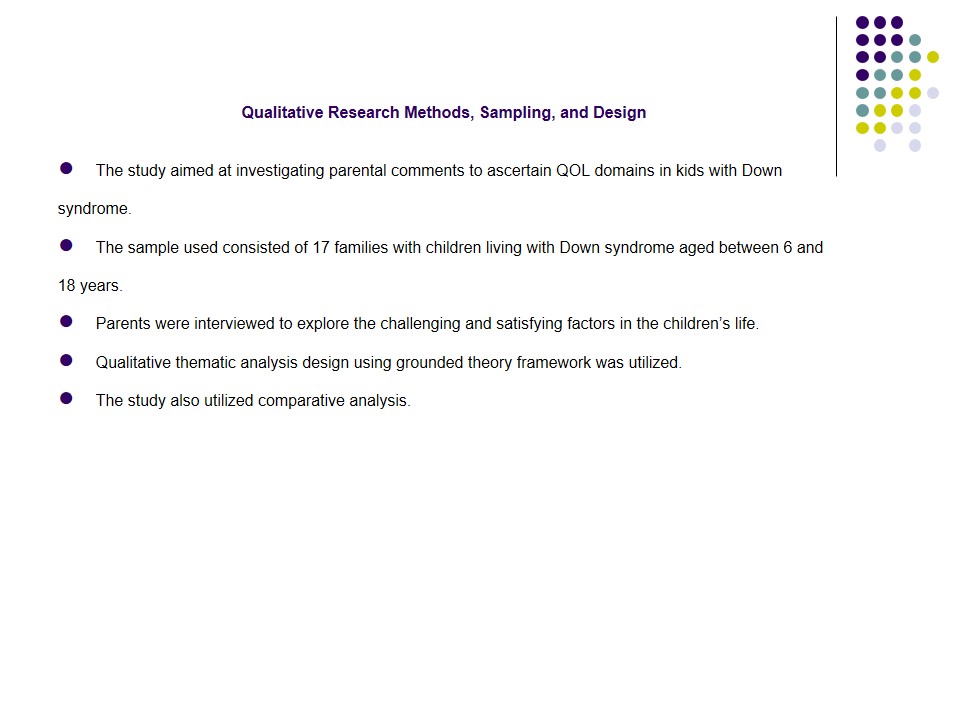
Results and Implication
The aspects affecting quality of life obtained are as follows:
- Physical health, physical activity and movement.
- Behavior and emotion.
- Personal value and communication.
- Routines and predictability.
- Independence relationships, social connectedness, and autonomy.
The identified aspects provide framework and evidence based foundation.
The identified aspects provide a framework to be applied in planning communication, comprehensive health, participation and social supports. It has also provided evidence based foundation, which can be utilized to research and examine the child’s with Down syndrome perspective on their quality of life.
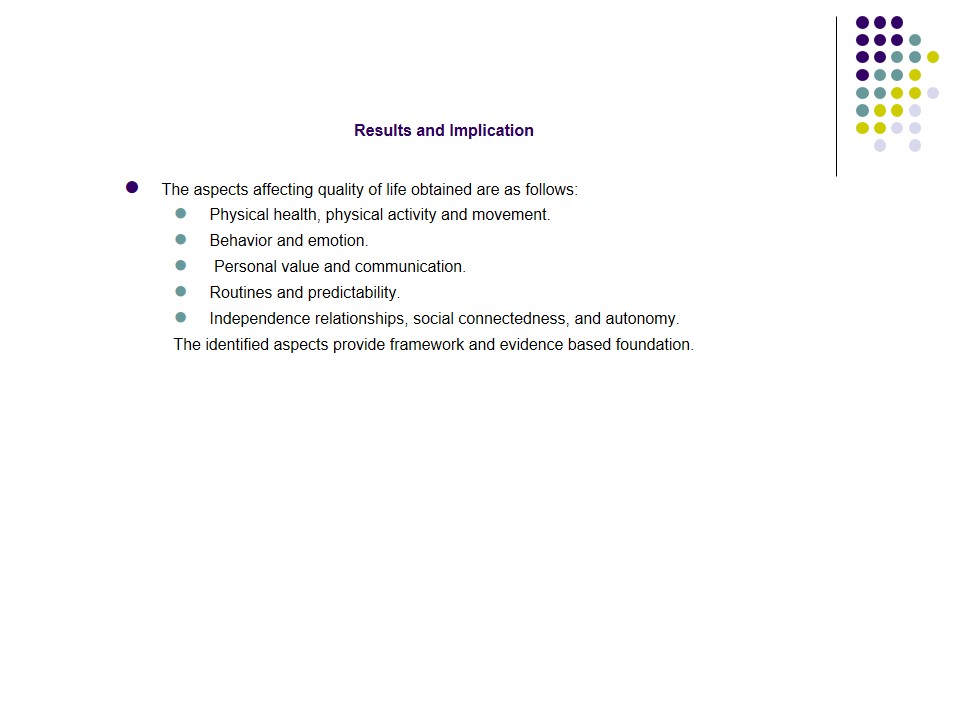
Informatics in the qualitative Research
- Internet recruitment.
- Instead of hiring research officers to conduct interviews, internet would have been used.
- Data collection would have been done in digital forms by using qualitative data software (Ahmad et al., 2018).
- Reduced errors in data coding and analysis.
- Data would have been copied directly from source and pasted in a software for analysis.
- Data ethics.
The subjects would have been selected through the internet, this increases sensitivity. Internet recruitment enhances purposive sampling when selecting parents with children with disabilities. Data ethics would be core of the research, thus, guidelines to protect patients’ information and confidentiality will be formulated. The digital systems would be have passwords to avoid data breach when information is being recorded, stored, transferred, or being accessed.
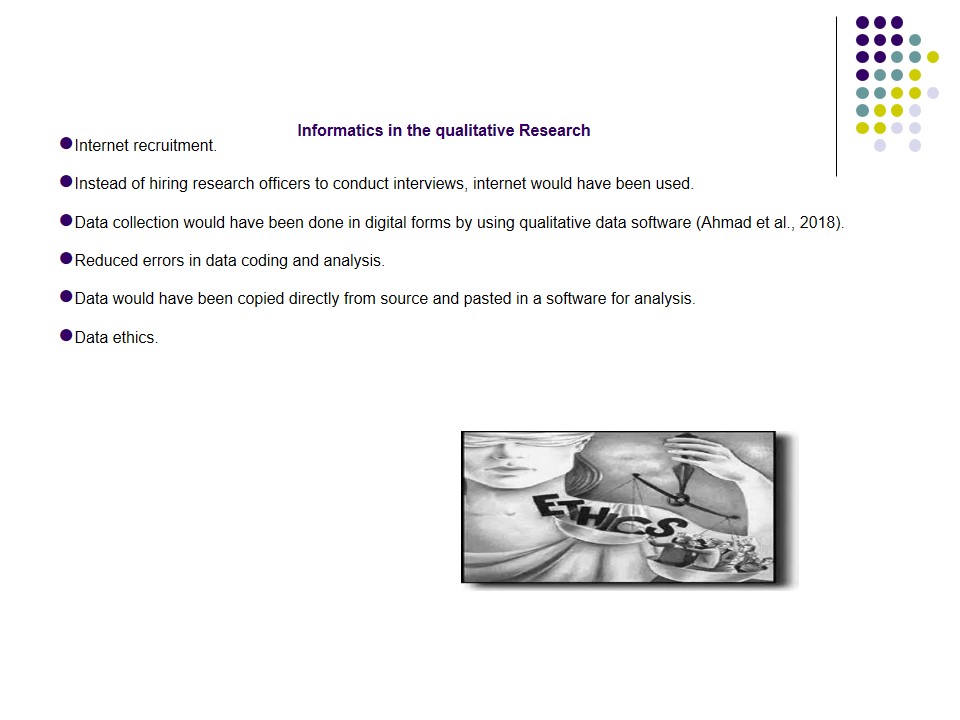
Informatics in the Quantitative Research
- Creating dataset from the findings and making it shareable to improve evidence based practices (Ahmad et al., 2018).
- Video conferencing to be used in data collection for interviewing parents about their experiences.
- Creating platform for sharing.
- Creating an app for collecting data when surveying.
- Creating digital visualization and analytics tools in the information system.
Zoom, Skype, or Video would have been used for interviewing parents about their experiences.
The data sharing platform could have been created for the parents of the disabled children to share information with the researchers. This would have enabled them to log in and write their experiences and other information needed such as sickness benefits.
Survey forms would have been filled electronically using an app created for the purpose. Visualization and analytic tools enables increased utilization of information effectiveness by aggregating them to illustrate several trends (Ahmad et al., 2018).
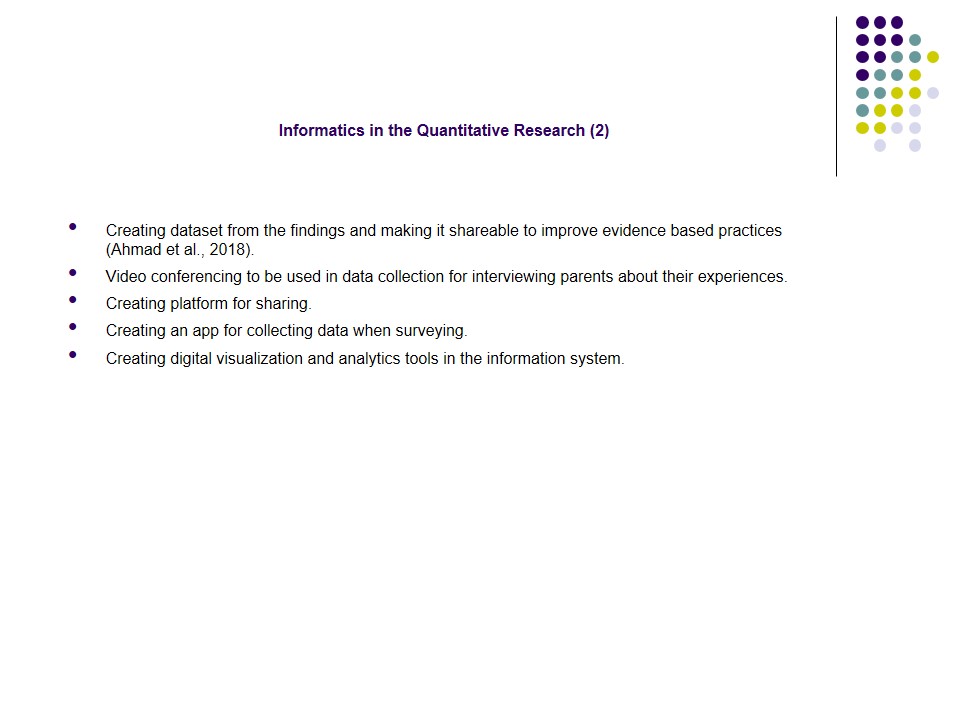
References
Ahmad, M. M., Musallam, R., & Allah, A. H. (2018). Nurses and internet health-related information: Review on access and utility. Clujul Medical, 91(3), 266. Web.
Murphy, N., Epstein, A., Leonard, H., Davis, E., Reddihough, D., Whitehouse, A., & Downs, J. (2017). Qualitative analysis of parental observations on quality of life in Australian children with Down syndrome. Journal of Developmental and Behavioral Pediatrics: JDBP, 38(2), 161. Web.
Wendelborg, C., & Tøssebro, J. (2016). Self-reported health and sickness benefits among parents of children with a disability. Scandinavian Journal of Disability Research, 18(3), 210-221. Web.
Zablotsky B., Black, L. I., & Blumberg, S. J. (2017). Estimated prevalence of children with diagnosed developmental disabilities in the United States, 2014-2016. National Center for Health Statistics. Web.